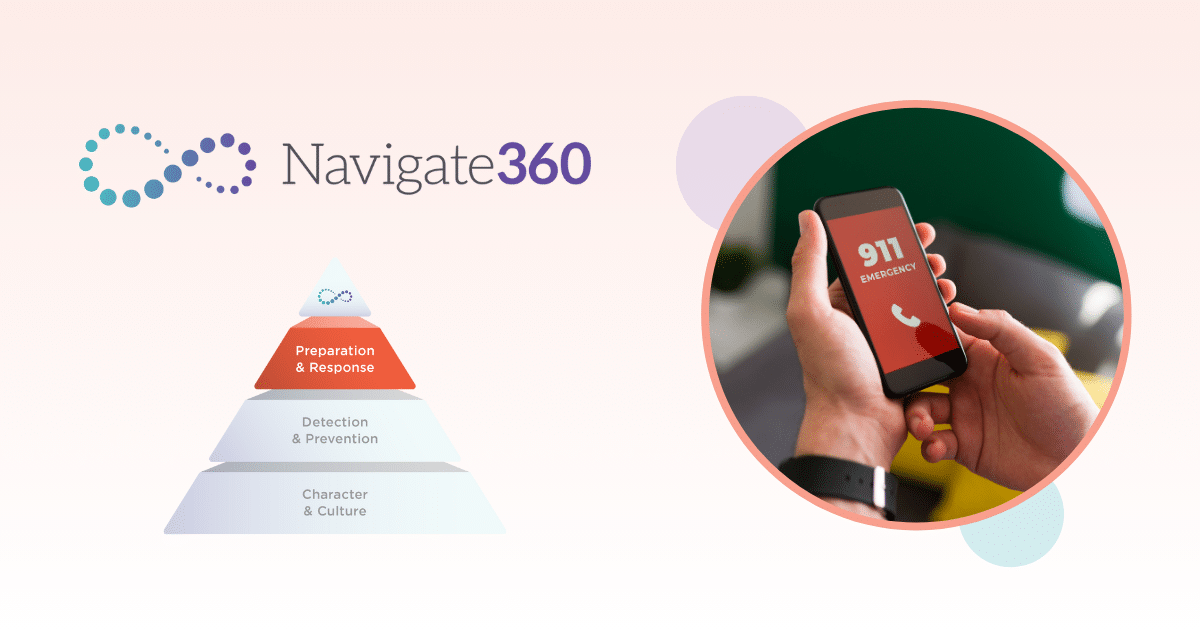School districts need to be prepared for a variety of emergencies. Having a comprehensive emergency operation plan (EOP) in place can greatly reduce the risk of harm to staff and students from natural or man-made threats. A district-wide EOP is more than just a good idea; it’s often the law. In fact, as of 2019, at least 43 states and the District of Columbia require a school safety plan in statute or regulation. Your district’s EOP should address the findings of school site risk assessments or security audits and include beginning-to-end guidance for students, teachers, and school personnel for responding to a variety of crisis scenarios, such as fires, natural disasters, active shooter, and pandemics. Your plan should also be reviewed and updated annually.
Here’s how to create a comprehensive emergency operation plan that will instill confidence in school personnel, students and parents in your district and meet state and federal guidelines.
Form a District Emergency Planning Team
The first step toward creating your district’s emergency operation plan is to form a team composed of a range of school personnel, including administrators, teachers, school psychologists/counselors and nurses. It should also include community partners such as law enforcement officials, emergency medical services personnel and school resource officers (SRO).
Once your team is assembled, begin drafting policies and procedures that meet state requirements and the specific needs of your school district. These policies and procedures should guide individual schools on how to form and support their own emergency planning teams. Assign roles and responsibilities to stakeholders and set up a regular meeting schedule.
Perform School-Site Risk Assessments & Security Audits
Before creating an emergency operation plan, planning teams should assess the current situation of the district: Are there gaps in safety and security? What are the safety risks of each building? Are the emergency response and security protocols compliant with state requirements? Hire a certified risk assessment specialist like an ASIS-certified Physical Security Professional (PSP) to identify the secure, vulnerable and dangerous areas of each of your schools. With this information, prioritize risks within your EOP and make critical security updates to correct issues before they become hazardous.
Risks can include natural disasters posed by the local environment, poor security features at a school, and even the physical condition of the school building itself. A school security audit checklist will help you take action to mitigate risk and ensure compliance across your district.
Once your team is assembled, begin drafting policies and procedures that meet state requirements and the specific needs of your school district. These policies and procedures should guide individual schools on how to form and support their own emergency planning teams. Assign roles and responsibilities to stakeholders and set up a regular meeting schedule.
Help Schools Develop Comprehensive EOPs
As the leader of your district, you must support schools in developing comprehensive EOPs for each threat revealed by the risk assessment and as required by law. EOPs should determine a course of action for school personnel and outline how quickly they need to respond. When implementing an EOP, ensure individual roles and responsibilities are assigned and understood by all stakeholders. Examples of key roles that should be outlined in an EOP include the following:
Principal/Administrator
As the leader of the school, the principal and/or administrator is responsible for the overall safety of students and staff. They take responsibility for critical steps put in place by the EOP, which can include coordinating evacuation, organizing sheltering in place and communicating with law enforcement and emergency services personnel.
Teachers
Teachers are responsible for their students and should direct them appropriately when receiving emergency alerts over the intercom or via other official methods of communication as outlined by the EOP. Transferring students inside or outside, taking attendance after each move and reporting missing students to the administrator are all essential actions for teachers during an emergency.
School Psychologists/Counselors
School psychologists and counselors can help with actualizing steps in the EOP as the situation necessitates, including helping teachers relocate students and rendering first aid if needed.
Nurses
Nurses and other health professionals can administer first aid, supervise others who have the medical training to provide it, and keep medical supplies organized.
School Resource Officers and Law Enforcement Officials
A School Resource Officer (SRO) is employed with a law enforcement agency and serves as a resource for the school district. SROs are key to ensuring collaboration and communication between districts and law enforcement community partners.
Considerations for Compliance
Emergency operation plans must comply with state regulations, which may include direction on the following:
Completing School Safety Audits
Comprehensive risk assessments and security checklists should be performed every year to identify new threats that may have arisen. Currently, 13 states and the District of Columbia require school safety audits.
Running Safety Drills
Conducting regular safety drills in the new school year is vital, as it trains incoming students and new hires in proper emergency response and retrains those who are returning to the school. It is also important to run a variety of safety drills in response to different threats, such as severe weather, intruders and school violence. Currently, 42 states require safety or security drills, typically monthly or annually.
In addition to these state requirements, emergency preparation plans must comply with:
- The Americans With Disabilities Act – Ensures emergency plans accommodate disabled members of the school system
- Title VI of the Civil Rights Act of 1964 – includes provisions for students and parents with limited English proficiency (LEP) and other language barriers
- Alyssa’s Law – Requires installation of silent panic alarms that trigger a quick response from law enforcement
Conduct District-Wide Emergency Plan Training & Regular Reviews
When you have created and implemented a districtwide EOP that complies with the above requirements, continue to hold regular meetings with all stakeholders at least once a year to practice the responses outlined in the plan. Training exercises can include visiting evacuation sites, running on-campus drills during the school day, engaging with small groups for tabletop discussions and simulating emergency events. Establish a cadence for getting your planning team together to review the current EOP and make any necessary revisions. Finally, be sure that all members of your school district, including staff and students, have ongoing access to the most up-to-date plan.
How We Can Help: Delivering Integrated Solutions that Work Better Together Take Your Emergency, Visitor & Volunteer Management to the Next Level with Navigate360’s Safety & Security Suite
Setting the new standard for modern school safety, our Safety & Security Suite integrates state-of-the-art Visitor, Volunteer and Emergency Management systems with Alyssa’s Law-compliant panic buttons, enabling your staff to directly – and silently – alert first responders when faced with an emergency incident. The cloud-based solution enables 360-degree visibility of the school building and the location of students, staff, visitors and volunteers, which is critical when every second counts. Integrating these features ensures real-time, whole-campus oversight and accountability, improving communication pathways between first responders, school staff, students and families, including reunification during a crisis.
Navigate360’s Safety & Security Suite provides your school with myriad features and benefits, including enhanced communication, robust safety checks, guidance to ensure Department of Education compliance, and comprehensive site mapping. Operating as a single visitor, volunteer, panic button and emergency management solution set, this system can offer additional benefits, including the following.
Integration & Communication
- Connected systems, including SIS integration, to improve information verification processes
- Access to Alyssa’s Law-compliant silent panic alerts across wearables, smartwatches, smartphones and wall-mounted devices to enable instant connection with first responders
- Communication platforms to facilitate the flow of vital information between law enforcement, school staff and families to improve efficiency of school security processes, including expedited student and family reunification during a crisis
Safety
- Real-time sex offender checks of visitors and sex offender and criminal background screenings of volunteers
- Parent custody reviews
- Student attendance tracking for tardiness and early releases
- System dashboard that ensures the front office can maintain oversight of all visitors and students on campus
- Reunification of students with parents and approved guardians during high-stress emergencies, following Standard Reunification Method (SRM) protocols
Compliance
- Prepopulated drills aligned to district and state requirements
- Approved EOP templates with wizard guidance that ensures accurate information entry by school personnel to comply with DOE requirements
Oversight
- 360-degree campus views through site mapping and drawing so first responders can better assess crisis situations and establish appropriate entry and exit points to maintain physical safety
For more information about how Navigate360’s Safety & Security Suite empowers school leaders to develop, document and implement comprehensive districtwide emergency operation plans, contact us today.




